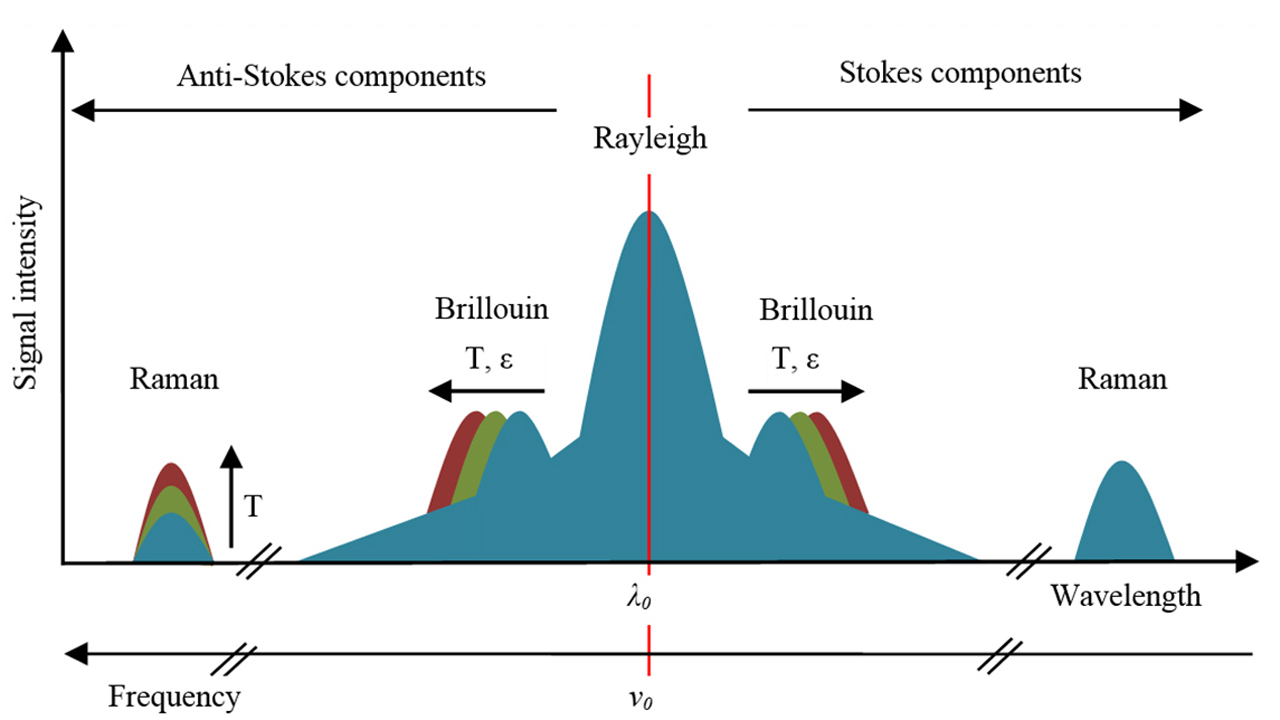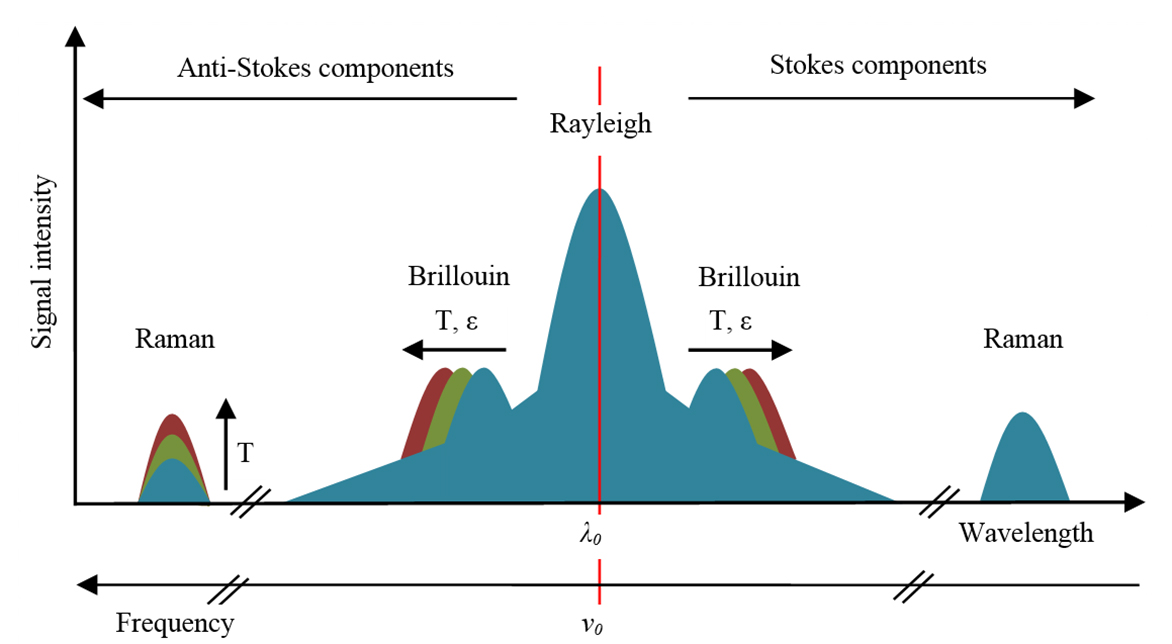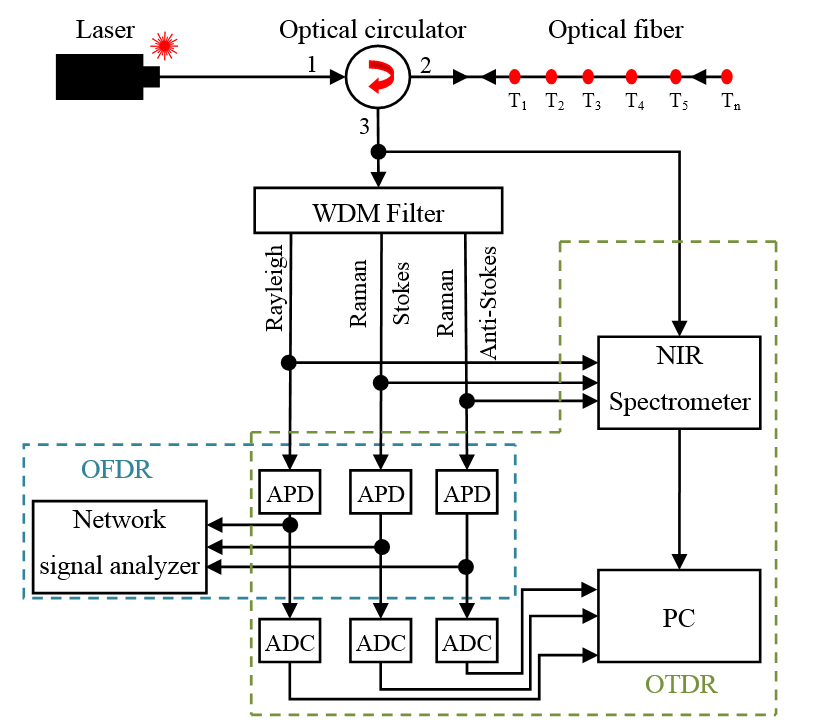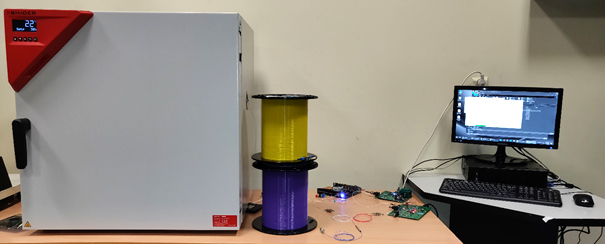NIR Raman scattering system for distributed temperature sensing with low-power long distance laser excitations

Introduction
Fiber optics are used as various sensors of different physical quantities for years. Distributed measurement systems are ones of the very promising applications of fiber optics today. Huge interest of fiber optics results from the amount of valuable information optical fibers can deliver. The environmental changes around the optical fiber cause changes of the optical fibers’ parameters, such as attenuation, dispersion, refractive index and light scattering. Optical fiber-based measurements systems are becoming popular due to the low cost, immunity to electromagnetic interferences, durability and high sensitivity. Distributed Optical Fiber Sensors (DOFS) are mainly based on the light scattering phenomena. Light scattering in optical fibers is basically caused by the interaction between photons and medium particles. Light scatters in every direction and can be enhanced by exterior factors such as strain and temperature. There are two major types of light scattering: elastic and inelastic ones. In the elastic scattering, the frequency of incident and the frequency of the scattered photons are equal, while in the inelastic scattering the frequency of the scattered photons is shifted to lower (Stokes) or higher (Anti-Stokes) frequencies. These shifts are equal to the characteristic vibration frequencies of the molecules. Rayleigh scattering is the elastic scattering phenomenon that results from the irregularity of the molecular structure, and it has the high impact on optical fiber’s attenuation. Brillouin scattering is the inelastic scattering that occurs due to strain or thermally excited acoustic waves. Raman scattering is also the inelastic scattering and it is enhanced by temperature-dependent molecular vibrations. DOFS are capable of measuring the appropriate quantity along the optical fiber at distance of tens of kilometers. Nowadays, the measurements of strain, temperature, oil and gas leaks and fire detection are being applied in DOFS systems. Optical fibers can be used in optical transmission lines monitoring, structures’ health monitoring, pipeline monitoring, hydrology, nuclear industry and mining.
- Methods
Distributed Temperature Sensing (DTS) systems are mainly based on the measurement of the backscattered Raman Anti-Stokes due to its dependency on temperature changes. The backscattered Rayleigh and Raman Stokes are measured also in order to achieve more reliable measurements through applying various demodulation algorithms. Commonly, optical time domain reflectometry (OTDR) analysis are applied in the DTS systems, which relies basically on the attenuation measurement of the backscattered light, which is then applied to measure the location and temperature change along the optical fiber. Lasers in the OTDR based systems launch short, powerful pulses of light that travel along the optical fiber. The optical frequency domain reflectometry (OFDR) could also be applied in DTS systems. A beam of frequency modulated light is launched into the optical fiber, and the backscattered light is detected as a function of the modulation frequency. At the moment, a DTS system is being developed, based on a novel analysis method, combining the features of the OTDR and OFDR methods.
- Results
At the Institute of Electronics, mathematical models are being developed in order to obtain the crucial information regarding the best components to be integrated in the DTS system depending on the application and the intended spatial and temperature resolutions. A series of experiments for various systems’ set-ups and optical fibers is held in order to test and verify the light scattering phenomenon in optical fibers and its application in temperature measurements. For this purpose, custom laser control unit and an ultra-fast ADC unit were developed. In a certain DTS system set-up, where the NIR spectrometer is used, the use of Wavelength Division Multiplexing (WDM) filters was proved to be unnecessary, thanks to the development of a special demodulation algorithm.
- Conclusions
The main perspective of this research is to apply the proposed novel analysis method in practical applications with low-power laser diode excitation. Therefore, the software based on the novel method is currently being developed.
- Contact
- Prof. Bogusław Więcek
 , e-mail: This email address is being protected from spambots. You need JavaScript enabled to view it.
, e-mail: This email address is being protected from spambots. You need JavaScript enabled to view it.
- M.Sc. Iyad S. M. Shatarah, e-mail: This email address is being protected from spambots. You need JavaScript enabled to view it.
- Dr. Robert Olbrycht,
 , e-mail: This email address is being protected from spambots. You need JavaScript enabled to view it.
, e-mail: This email address is being protected from spambots. You need JavaScript enabled to view it.
- Prof. Bogusław Więcek
- Publication
- Shatarah I. S. M., Olbrycht R., Distributed temperature sensing in optical fibers based on Raman scattering: theory and applications, Measurement Automation Monitoring, vol. 63, no. 02, 2017, pp.41-44.
- Shatarah I. S. M. and Olbrycht R., Distributed temperature sensing in optical fibers based on Raman scattering: demodulation algorithms, Measurement Automation Monitoring, vol. 63, no. 02, 2017, pp. 45-47.
- Shatarah I. S. M., Oblrycht R. and Więcek B., Modeling of Spontaneous Raman Scattering in silica light guides for Distributed Temperature Sensing, 14th Quantitative Infrared Thermography Conference (QIRT), Berlin 2018, pp. 209-220, doi: 10.21611/qirt.2018.p52.
- Shatarah I. S. M., Imiela A., Surmacki J., Olbrycht R., Wittchen W., Borecki M., Abramczyk H., Więcek B., FeO content estimation in steel slag using Raman spectroscopy in NIR range, 14th Quantitative Infrared Thermography Conference (QIRT), Berlin 2018, doi: 10.21611/qirt.2018.p31.
- Shatarah I. S. M and Więcek B., Application of Software-Defined Radio for Rayleigh and Raman Scattering Measurement in Optical Fibers, Measurement Automation Monitoring, vol. 64, no. 04, 2018, pp.112-115.
- Shatarah I. S. M. and Więcek B., The application of NIR spectrometer for average temperature measurement in optical fibers based on spontaneous Raman scattering for DTS applications, MIXDES 2020 Conference Proceedings, Poland, 2020.
- Shatarah I. S. M. and Więcek B., Novel data analysis approach for Raman Scattering-based Distributed Temperature Sensing (DTS) systems, 15th Quantitative Infrared Thermography Conference (QIRT), Porto 2020.




